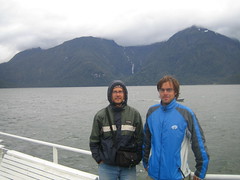San Vicente and the Salar
Clayton here. We arrived in Tupiza, Bolivia on Sunday. First on the agenda was to find a way to San Vicente, this being the small town where Butch and Sundance met their doom, 1908. Five hours in a jeep, mesmerized by the flight of two condors, an interesting life story from our driver (a coke addict saved by Jesus Christ), and we arrived in San Vicente. If I have the story right, after their stay in Argentina, attempting to ranch but finding the time to rob a couple of banks too, they headed north to Bolivia. After less than a year, sometimes working as guards for the mine payroll, but mostly casing out new "jobs", they robbed a caravan of horses carrying money for the mines. Fleeing to nearby San Vicente, they were finally cornered by a group of four Bolivian law enforcers. The shootout went into the night. Eventually, the yankee bandits stopped firing, and in the morning they were found dead. There is some speculation that they may have ended their own lives, but in any case, it wasn't quite like the movie. After posing for a couple of pics as the heroic bandidos, we had to stand in the town square and shout, "Don Federico!" until the Don came to let us into the museum. This was the oddest museum in the world, I have no doubt: one small room, a couple of old typewriters, an old jackhammer and a couple of kerosene lamps from the mines, the official suitcase of Butch Cassidy (riddled with bullet holes), and a human skeleton, missing some bones and having duplicates in other places. Odd.
The next day we set out on a four day tour of the southwest corner of the country. Day one was almost a repeat of our trip to San Vicente. We enjoyed the people we were with, that being a good thing because four days in a jeep together wasn't easy. Day two involved seeing Lago Verde, a vibrantly green lake; flamingoes; swampy hot springs that we swam in; and geysers spewing sulphur at 150-200 degrees celsius. Day three started with laguna Colorada, the "red lake" (which wasn't really red in the morning light); rock formations that looked like trees sticking out of the sand; a smoking volcano on the border with Chile; and it ended with a hot shower and a warm bed, neither of which were included in the first two nights. The food was nothing to complain about though. Day four was the climax of the tour: the Salar de Uyuni, a salt flat measuring about 12,000 square kilometres. It is hard to describe but I will not forget that sunrise. Blazing white nearly as far as you could see, and some parts were covered in water that created a perfect mirror. We drove across the salt mesmerized, then stopped to help another jeep with a flat tire. We discovered we also had a flat. After a half hour of taking "pictures without perspective" (you'll have to see them), we were on our way again. Ten minutes later we had another flat. Every day of the tour averaged about three breakdowns, which we are growing accustomed to. The rest of the morning was spent driving across this lake of salt, and I would recommend it to anyone. An interesting fact: they export the salt, using shovels and small trucks, at a price of five Bolivianos for 50 kgs (that's about 70 cents). Not a great cost-benefit ratio, but that's life in Bolivia. So far this country is as cheap as it gets. One of the restaurants gave us a steaming skillet with steak, hot dogs, eggs, french fries, fried bananas and an incredibly tasty mix of onions and tomatoes, all for two dollars (there should be a picture). It fed us both. Besides that, the land is some of the most unique I have seen: varied coloured mountains, green hills, bleak desert, llama ranches, fields of quinoa, trees of rock, sulphurous geysers, hot springs, green and red lakes, flamingoes, and a lake of salt. Most of the tour was spent above 4000 metres in elevation, the highest point being just over 4900. You do need time to acclimatize: walking up stairs will take your breath away, the sun seems to burn a little more brightly, and it's cold up there. Something I did not anticipate was the dramatic increase in bodily gases. Amazing really. In any case, you come to realize that Bolivians are survivors, besides being some of the nicest.
What else... in an hour, we will leave for Potosi, a mining city with the distinction of being the highest city in the world. Then it's on to La Paz, after which we will probably update the blog again. Hope all is well, and thanks for reading.


1 Comments:
When my mom (Aunt Bette) was a little girl living near Moyie, BC, about 15 miles from Cranbrook a trip to town in the neighbour's Model T (Grandad never did drive) always included at least one flat tire, and that was when everyone got out for the rather large picnic lunch.
Post a Comment
<< Home